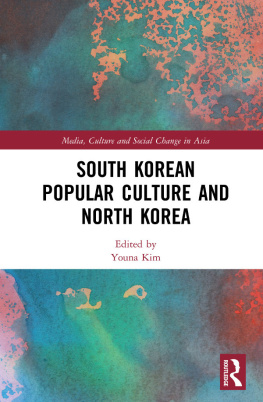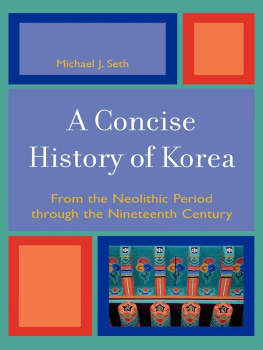A HISTORY OF KOREA

A HISTORY OF
KOREA
FROM
LAND OF THE MORNING CALM
TO STATES IN CONFLICT
JINWUNG KIM
INDIANA UNIVERSITY PRESS Bloomington and Indianapolis
This book is a publication of
Indiana University Press
601 North Morton Street
Bloomington, Indiana 47404-3797 USA
iupress.indiana.edu
Telephone orders 800-842-6796
Fax orders 812-855-7931
2012 by Kim Jinwung
All rights reserved
No part of this book may be reproduced or utilized in any form or by any means, electronic or mechanical, including photocopying and recording, or by any information storage and retrieval system, without permission in writing from the publisher. The Association of American University Presses Resolution on Permissions constitutes the only exception to this prohibition.
 The paper used in this publication meets the minimum requirements of the American National Standard for Information Sciences Permanence of Paper for Printed Library Materials, ANSI Z39.48-1992.
The paper used in this publication meets the minimum requirements of the American National Standard for Information Sciences Permanence of Paper for Printed Library Materials, ANSI Z39.48-1992.
Manufactured in the United States of America
Library of Congress Cataloging-in-Publication Data
Kim, Jinwung.
A history of Korea : from Land of the Morning Calm to states in conflict / Jinwung Kim.
pages cm
Includes bibliographical references and index.
ISBN 978-0-253-00024-8 (cloth : alkaline paper) ISBN 978-0-253-00078-1 (ebook) 1. KoreaHistory. 2. Korea (South)History. 3. Korea (North) History. I. Title.
DS 907.18. K 53296 2012
951.9dc23
2012032989
1 2 3 4 5 16 15 14 13 12
Contents
Acknowledgments
I deeply thank my Patron, Spencer C. Tucker, former John Biggs Chair of Military History at Virginia Military Institute and currently Senior Fellow of Military History at ABC-CLIO . Dr. Tucker helped me find a publisher for my work on the history of Korea and offered many suggestions and constructive criticism on my manuscript, all the while expressing endless enthusiasm for its publication. This book would never have been completed without his help and reassurance.
I also thank Robert J. Sloan and Sarah Wyatt Swanson, editorial director and assistant sponsoring editor, respectively, at Indiana University Press, for their excellent suggestions for improving the quality of the book. I also thank the anonymous reviewer of my manuscript for valuable suggestions and comments that further improved this work.
Finally, this book could not have been completed without the love and sacrifice of my daughter, Hyungeun Grace Kim. Her love for her father and endless encouragement helped make all this possible.
Jinwung Kim
Taegu, Republic of Korea
Introduction
Koreans, a branch of the Ural-Altaic family, began their long, rich history as small tribes entering Manchuria (Manzhou) and the Korean peninsula from the Asian mainland hundreds of thousands of years ago. The vast plains of Manchuria, which now belong to China, had been the main arena of activity for Koreans until AD 926, when the Korean kingdom of Parhae fell to Qidan (Khitan) Liao. At first the Korean people came together into a cluster of villages and tribal states, termed walled-town states. As stronger walled-town states subjugated weaker ones under their dominion, these walled-town states grew into confederated kingdoms, including Old Chosn, Puy, Kogury, Paekche, and Silla, as well as the Kaya confederation. Among these, the kingdoms of Kogury, Paekche, and Silla developed into centralized kingdoms, opening the period of the Three Kingdoms. When Silla unified two rival kingdoms in 676, or certainly when Kory ended the period of the Later Three Kingdoms in 936, Koreans finally came together into a single homogeneous nation that has kept its identity despite repeated invasions by surrounding countries and peoples.
During the Kory and Chosn dynasties, Korea was an autonomous, unified state with a sophisticated central government for a millennium. When Japan annexed the Chosn kingdom in 1910, Koreans lost their independence and came under Japanese colonial rule. Koreans tenaciously resisted unrelenting pressure from the Japanese to annihilate their way of life, and they succeeded in preserving their own culture intact. Since liberation from the Japanese in 1945, and as a result of the Cold War, Korea came to be divided into two states, North and South. Despite this division, Koreans in each state have regarded those in the other as their brethren and have aspired to reunification.
In short, throughout their long history, Koreans have endured all kinds of trials to maintain an ethnic and cultural identity quite separate from that of China or Japan. Koreans all speak the same language and share the same culture, and clearly their language, alphabet (hangl), arts, and customs are distinct from those of the Chinese and the Japanese.
Although it began as a small nation on the eastern tip of the Asian continent, Korea has had a long, important civilization. Koreas extensive history has been characterized both by the persistent assertion of a distinctive Korean identity and by military, political, and cultural assaults from external sources. Korean historians note that, throughout its history, Korea has been invaded by foreign aggressors once every two years on average. Given Koreas strategic location and the much greater power of its neighbors, first China, and then Japan and Russia, it is remarkable that the Korean nation has survived.
While establishing its national identity, the Korean nation has produced remarkable cultural achievements. Recently South Korea (Republic of Korea) has excelled from the standpoints of political and economic development. Indeed, it has been universally acclaimed as a political and economic success story. An internationally recognized middle power, South Korea is marked not only by a fully functioning modern democracy but also by a high-tech modern world economy. It has raised itself from the depths of devastation and poverty following the Korean War (19501953) and shaken off the shackles of authoritarian rule to become a fully democratic nation committed to human rights, the rule of law, and economic prosperity for its people. The history of South Korea is also one of the fastest socioeconomic growth stories in the world during the past six decades. As of 2008 it was the 15th largest economy and the 12th most active trading nation among 186 countries. It has become a much more dynamic and creative society than it was 20 years ago. The country is now a leader in information technology, and its popular culture, known as hallyu, or the Korean wave, dominates much of Asia. South Koreas full-fledged democracy and internationally oriented, prospering economy has earned it recognition as the legitimate government on the Korean peninsula.
Throughout its history the Korean nation has been influenced by the immense power and culture of China. Historically the Chinese were far more numerous and more powerful militarily than Koreans; their technology and culture were also more advanced. Before 1895 successive Chinese dynasties from the Han to the Qing empires exerted great power and influence on Korea. Koreans drew from the Chinese model in organizing its political institutions, and the Korean adoption of the Chinese political system extended to society and culture. But this adoption of Chinese institutions and culture was not an expression of submission. Rather, it was the indispensable condition of being civilized in the East Asian context. It did not obliterate the identity of the Korean people.











 The paper used in this publication meets the minimum requirements of the American National Standard for Information Sciences Permanence of Paper for Printed Library Materials, ANSI Z39.48-1992.
The paper used in this publication meets the minimum requirements of the American National Standard for Information Sciences Permanence of Paper for Printed Library Materials, ANSI Z39.48-1992.